Vulnerability of Thermal Energy Storage Lining Material to Erosion Induced by Particulate Flow in Concentrated Solar Power Tower Systems
Abstract
:1. Introduction
2. Experimental Setup and Tested Materials
2.1. Accelerated High-Temperature Direct-Impact Experiment
2.2. Low-Velocity Cold Experiment
3. Results
3.1. Accelerated High-Temperature Direct-Impact Experiment
3.2. Low-Velocity Cold Experiment
4. Conclusions
Author Contributions
Funding
Institutional Review Board Statement
Informed Consent Statement
Data Availability Statement
Acknowledgments
Conflicts of Interest
References
- Albrecht, K.J.; Carlson, M.D.; Ho, C.K. Integration, control, and testing of a high-temperature particle-to-sCO2 heat exchanger. In AIP Conference Proceedings; AIP Publishing LLC: Melville, NY, USA, 2019; Volume 2126, p. 030001. [Google Scholar]
- Albrecht, K.J.; Ho, C.K. Design and operating considerations for a shell-and-plate, moving packed-bed, particle-to-sCO2 heat exchanger. Sol. Energy 2019, 178, 331–340. [Google Scholar] [CrossRef]
- Albrecht, K.; Amogne, D.; Byman, A.; Moon, D.; Jordison; Ho, C. Design and Testing of a Prototype Particle/sCO2 Heat Exchanger at Gen3 Operating Conditions; No. SAND2022-13729C; Sandia National Laboratories (SNL-NM): Albuquerque, NM, USA, 2022. [Google Scholar]
- Albrecht, K.J.; Laubscher, H.F.; Bowen, C.P.; Ho, C.K. Performance Evaluation of a Prototype Moving Packed-Bed Particle/sCO2 Heat Exchanger; No. SAND2022-12615; Sandia National Lab. (SNL-NM): Albuquerque, NM, USA, 2022. [Google Scholar]
- DeLovato, N.A.; Albrecht, K.; Ho, C. Thermomechanical modeling of counter-flow packed-bed particle-to-sCO2 heat exchangers. In AIP Conference Proceedings; AIP Publishing: Melville, NY, USA, 2022; Volume 2445. [Google Scholar]
- Ho, C. Evaluation of Particle-to-sCO2 Heat Exchangers and On-Sun Testing (Presentation for DOE CSP Summit); No. SAND2021-10299PE; Sandia National Lab. (SNL-NM): Albuquerque, NM, USA, 2021. [Google Scholar]
- Ho, C.K. Advances in central receivers for concentrating solar applications. Sol. Energy 2017, 152, 38–56. [Google Scholar] [CrossRef]
- Ho, C.K.; Kim, J.S.; Kumar, A. Multi-Stage Falling Particle Receivers; No. 10,914,493; Sandia National Lab. (SNL-NM): Albuquerque, NM, USA, 2021. [Google Scholar]
- Lance, B.; Ho, C.K.; Albrecht, K.U.S. Systems and Methods for Particle-Enhanced Dry Heat Rejection and Thermal. Storage Patent No. 11835300, 5 December 2023. [Google Scholar]
- Sment, J.; Albrecht, K.; Christian, J.; Ho, C.K. Optimization of Storage Bin Geometry for High Temperature Particle-Based CSP Systems. In Energy Sustainability; American Society of Mechanical Engineers: New York, NY, USA, 2019; Volume 59094, p. V001T03A008. [Google Scholar]
- Sment, J.; Albrecht, K.; Martinez, M.J.; Ho, C.K. Design considerations for a high-temperature particle storage bin. In AIP Conference Proceedings; AIP Publishing LLC: Melville, NY, USA, 2020; Volume 2303, p. 190029. [Google Scholar]
- Sment, J.N.; Martinez, M.J.; Albrecht, K.; Ho, C.K. Testing and Simulations of Spatial and Temporal Temperature Variations in a Particle-Based Thermal Energy Storage Bin. In Energy Sustainability; American Society of Mechanical Engineers: New York, NY, USA, 2020; Volume 83631, p. V001T02A010. [Google Scholar]
- Alaqel, S.; Djajadiwinata, E.; Saleh, N.S.; Saeed, R.S.; Alswaiyd, A.; Al-Ansary, H.; El-Leathy, A.; Jeter, S.; Danish, S.; Al-Suhaibani, Z.; et al. On-sun experiments on the world’s first deployed gas-turbine particle-based power tower facility at King Saud University. In AIP Conference Proceedings; AIP Publishing LLC: Melville, NY, USA, 2022; Volume 2445, p. 060001. [Google Scholar] [CrossRef]
- Al-Ansary, H.; El-Leathy, A.; Jeter, S.; Djajadiwinata, E.; Alaqel, S.; Golob, M.; Nguyen, C.; Saad, R.; Shafiq, T.; Danish, S.; et al. On-sun experiments on a particle heating receiver with red sand as the working medium. In AIP Conference Proceedings; AIP Publishing LLC: Melville, NY, USA, 2018; Volume 2033, p. 040002. [Google Scholar] [CrossRef]
- El-Leathy, A.; Al-Ansary, H.; Jeter, S.; Djajadiwinata, E.; Alaqel, S.; Golob, M.; Nguyen, C.; Saad, R.; Shafiq, T.; Danish, S.; et al. Preliminary tests of an integrated gas turbine-solar particle heating and energy storage system. In AIP Conference Proceedings; AIP Publishing LLC: Melville, NY, USA, 2018; Volume 2033, p. 040013. [Google Scholar] [CrossRef]
- Alaqel, S.; El-Leathy, A.; Al-Ansary, H.; Djajadiwinata, E.; Saleh, N.; Danish, S.; Saeed, R.; Alswaiyd, A.; Al-Suhaibani, Z.; Jeter, S.; et al. Experimental investigation of the performance of a shell-and-tube particle-to-air heat exchanger. Solar Energy 2020, 204, 561–568. [Google Scholar] [CrossRef]
- Saleh, N.S.; Alaqel, S.; Djajadiwinata, E.; Saeed, R.S.; Alswaiyd, A.; Al-Ansary, H.; El-Leathy, A.; Jeter, S.; Danish, S.; Al-Suhaibani, Z.; et al. An experimental investigation of heat losses during charging the thermal storage tank in a particle-based CSP system. In AIP Conference Proceedings; AIP Publishing LLC: Melville, NY, USA, 2022; Volume 2445, p. 160015. [Google Scholar] [CrossRef]
- Plewe, K.; Sment, J.N.; Albrecht, K.; Ho, C.K.; Chen, D. Transient system analysis of a Gen3 particle-based CSP plant with spatially resolved thermal storage charging and discharging. In AIP Conference Proceedings; AIP Publishing: Melville, NY, USA, 2023; Volume 2815. [Google Scholar]
- Sment, J.; Magaldi, M.; Repole, K.; Ho, C.K.; Schroeder, N. Design considerations for horizontal high-temperature particle conveyance components. In AIP Conference Proceedings; AIP Publishing: Melville, NY, USA, 2023; Volume 2815. [Google Scholar]
- Chen, R.; Romero, M.; González-Aguilar, J.; Rovense, F.; Rao, Z.; Liao, S. Design and off-design performance comparison of supercritical carbon dioxide Brayton cycles for particle-based high temperature concentrating solar power plants. Energy Convers. Manag. 2021, 232, 113870. [Google Scholar] [CrossRef]
- Rovense, F.; Reyes-Belmonte, M.; González-Aguilar, J.; Amelio, M.; Bova, S.; Romero, M. Flexible electricity dispatch for CSP plant using un-fired closed air Brayton cycle with particles based thermal energy storage system. Energy 2019, 173, 971–984. [Google Scholar] [CrossRef]
- Albrecht, K.J.; Bauer, M.L.; Ho, C.K. Parametric analysis of particle CSP system performance and cost to intrinsic particle properties and operating conditions. In Energy Sustainability; American Society of Mechanical Engineers: New York, NY, USA, 2019; Volume 59094, p. V001T03A006. [Google Scholar]
- Heller, L.; Többen, D.; Hirsch, T.; Buck, R. The cost-saving potential of next-generation particle technology CSP with steam cycles. Sol. Energy 2023, 263, 111954. [Google Scholar] [CrossRef]
- Gan, P.G.; Ye, W.; John, P. System Modelling and Optimization of a Particle-Based CSP System; The Australian National University: Canberra, Australia, 2021. [Google Scholar]
- Nie, F.; Bai, F.; Wang, Z.; Li, X.; Yang, R. Solid particle solar receivers in the next-generation concentrated solar power plant. EcoMat 2022, 4, e12207. [Google Scholar] [CrossRef]
- Sang, L.; Wang, K.; Zhang, R.; Wang, Y.; Wu, Y. Effective thermal conductivity and thermal cycling stability of solid particles for sCO2 CSP applications. Sol. Energy Mater. Sol. Cells 2022, 242, 111764. [Google Scholar] [CrossRef]
- Alaqel, S.; Saleh, N.S.; Saeed, R.; Djajadiwinata, E.; Sarfraz, M.; Alswaiyd, A.; Al-Ansary, H.; Zeitoun, O.; Danish, S.; Al-Suhaibani, Z.; et al. Particle-to-fluid direct-contact counter-flow heat exchanger: Simple-models validation and integration with a particle-based central tower system. Case Stud. Therm. Eng. 2022, 33, 101994. [Google Scholar] [CrossRef]
- Alaqel, S.; Saleh, N.S.; Djajadiwinata, E.; Saeed, R.; Alswaiyd, A.; Al-Ansary, H.; El-Leathy, A.; Zeitoun, O.; Jeter, S.; Abdel-Khalik, S.; et al. A novel particle-to-fluid direct-contact counter-flow heat exchanger for CSP power generation applications: Design features and experimental testing. Renew. Energy 2021, 170, 905–926. [Google Scholar] [CrossRef]
- Alaqel, S.; Djajadiwinata, E.; Saeed, R.S.; Saleh, N.S.; Al-Ansary, H.; El-Leathy, A.; Danish, S.; Al-Suhaibani, Z.; Shafiq, T.; Golob, M.; et al. Performance of the world’s first integrated gas turbine–solar particle heating and energy storage system. Appl. Therm. Eng. 2022, 215, 119049. [Google Scholar] [CrossRef]
- Palacios, A.; Calderón, A.; Barreneche, C.; Bertomeu, J.; Segarra, M.; Fernández, A.I. Study on solar absorptance and thermal stability of solid particles materials used as TES at high temperature on different aging stages for CSP applications. Sol. Energy Mater. Sol. Cells 2019, 201, 110088. [Google Scholar] [CrossRef]
- Flamant, G.; Grange, B.; Wheeldon, J.; Siros, F.; Valentin, B.; Bataille, F.; Zhang, H.; Deng, Y.; Baeyens, J. Opportunities and challenges in using particle circulation loops for concentrated solar power applications. Prog. Energy Combust. Sci. 2023, 94, 101056. [Google Scholar] [CrossRef]
- Liu, M.; Jacob, R.; Belusko, M.; Riahi, S.; Bruno, F. Techno-economic analysis on the design of sensible and latent heat thermal energy storage systems for concentrated solar power plants. Renew. Energy 2021, 178, 443–455. [Google Scholar] [CrossRef]
- 2014 SunShot Initiative Portfolio Book. Available online: https://www.energy.gov/eere/solar/articles/download-sunshot-initiative-2014-portfolio (accessed on 19 March 2024).
- Martin, J.; Vitko, J., Jr. ASCUAS: A Solar Central Receiver Utilizing a Solid Thermal Carrier; Sandia National Laboratories (SNL-CA): Livermore, CA, USA, 1982. [Google Scholar] [CrossRef]
- Hruby, J.; Steeper, R.; Evans, G.; Crowe, C. An Experimental and Numerical Study of Flow and Convective Heat Transfer in a Freely Falling Curtain of Particles. J. Fluids Eng. 1988, 110, 172–181. [Google Scholar] [CrossRef]
- Falcone, P.K. Technical Review of the Solid Particle Receiver Program; Meeting Held in Livermore; Sandia National Laboratories (SNL-CA): Livermore, CA, USA, 1984; pp. 25–26. [Google Scholar]
- Falcone, P.K.; Noring, J.E.; Hruby, J.M. Assessment of a Solid Particle Receiver for a High Temperature Solar Central Receiver System; No. SAND85-8208; Sandia National Laboratories (SNL-CA): Livermore, CA, USA, 1985. [Google Scholar]
- Saeed, R.; Alswaiyd, A.; Saleh, N.S.; Alaqel, S.; Djajadiwinata, E.; Al-Ansary, H.; Danish, S.N.; El-Leathy, A.; Al-Suhaibani, Z.; Almutairi, Z.; et al. An experimental investigation of chevron-shaped discrete structure configuration on the particle flow behavior of particle heating receivers. Results Eng. 2024, 21, 101786. [Google Scholar] [CrossRef]
- Saeed, R.S.; Alswaiyd, A.; Al-Ansary, H.; El-Leathy, A.; Jeter, S.; Alaqel, S.; Saleh, N.S.; Djajadiwinata, E.; Al-Suhaibani, Z.; Danish, S.; et al. Effect of the cyclic heating (aging) on the solar absorptance and specific heat of particulate materials. In AIP Conference Proceedings; AIP Publishing: Melville, NY, USA, 2022; Volume 2445, p. 020012. [Google Scholar] [CrossRef]
- Zunft, S.; Hänel, M.; Krüger, M.; Dreißigacker, V.; Göhring, F.; Wahl, E. Jülich solar power tower—Experimental evaluation of the storage subsystem and performance calculation. J. Sol. Energy Eng. 2011, 133, 031019. [Google Scholar] [CrossRef]
- Nandi, B.R.; Bandyopadhyay, S.; Banerjee, R. Analysis of high temperature thermal energy storage for solar power plant. In Proceedings of the 2012 IEEE Third International Conference on Sustainable Energy Technologies (ICSET), Kathmandu, Nepal, 24–27 September 2012; IEEE: Piscataway, NJ, USA, 2012; pp. 438–444. [Google Scholar]
- Nandi, B.R.; Bandyopadhyay, S.; Banerjee, R. Numerical modeling and analysis of dual medium thermocline thermal energy storage. J. Energy Storage 2018, 16, 218–230. [Google Scholar] [CrossRef]
- Nandi, B.R. Thermal Storage for Solar Thermal Power Plants. Ph.D. Thesis, Indian Institute of Technology Bombay, Mumbai, India, 2019. [Google Scholar]
- Zhao, J.; Korba, D.; Mishra, A.; Klausner, J.; Randhir, K.; AuYeung, N.; Li, L. Particle-based high-temperature thermochemical energy storage reactors. Prog. Energy Combust. Sci. 2024, 102, 101143. [Google Scholar] [CrossRef]
- Mishra, A.; Korba, D.; Zhao, J.; Li, L. Heat and mass transfer model for a counter-flow moving packed-bed oxidation reactor/heat exchanger. J. Sol. Energy Eng. 2024, 1–30. [Google Scholar] [CrossRef]
- El-Leathy, A.; Jeter, S.; Al-Ansary, H.; Danish, S.N.; Saeed, R.; Abdel-Khalik, S.; Golob, M.; Djajadiwinata, E.; Al-Suhaibani, Z. Thermal performance evaluation of lining materials used in thermal energy storage for a falling particle receiver based CSP system. Sol. Energy 2019, 178, 268–277. [Google Scholar] [CrossRef]
- KERN PLJ 4000-2M Manuals. Available online: https://www.manualslib.com/products/Kern-Plj-4000-2m-10073864.html (accessed on 19 March 2024).
- Holman, J.P. Experimental Methods for Engineers, 7th ed.; Tata McGraw Hill Education Private Limited: New York, NY, USA, 2007. [Google Scholar]
- Refractories for Aluminum. Available online: https://pub-mediabox-storage.rxweb-prd.com/exhibitor/document/exh-6bfc830c-299e-49c3-aac4-47f87d85477f/597d39cc-2d64-4792-8c2c-c09690c028ef.pdf (accessed on 5 March 2024).
- Refractories for Heat Treating & Forging. Available online: https://alliedrussia.com/wp-content/uploads/2018/12/BR_HTF.pdf (accessed on 5 March 2024).
- Waste Incineration. Available online: https://alliedrussia.com/wp-content/uploads/2019/12/BR_Incineration-and-Power.pdf (accessed on 5 March 2024).
- JM Insulating Firebrick Series. Available online: https://www.morganthermalceramics.com/media/5beap13n/jm-ifb-series_eng.pdf (accessed on 19 March 2024).
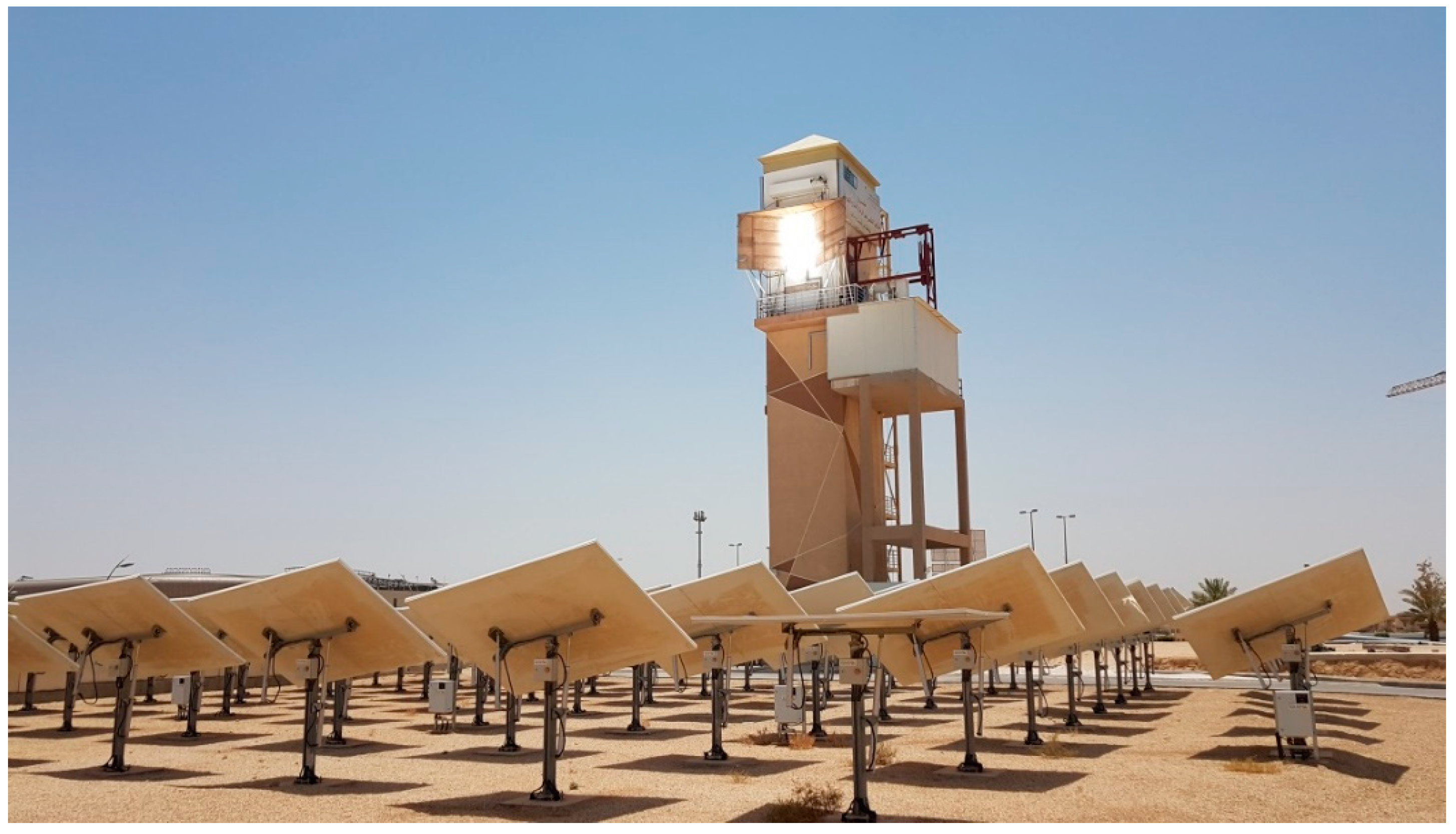
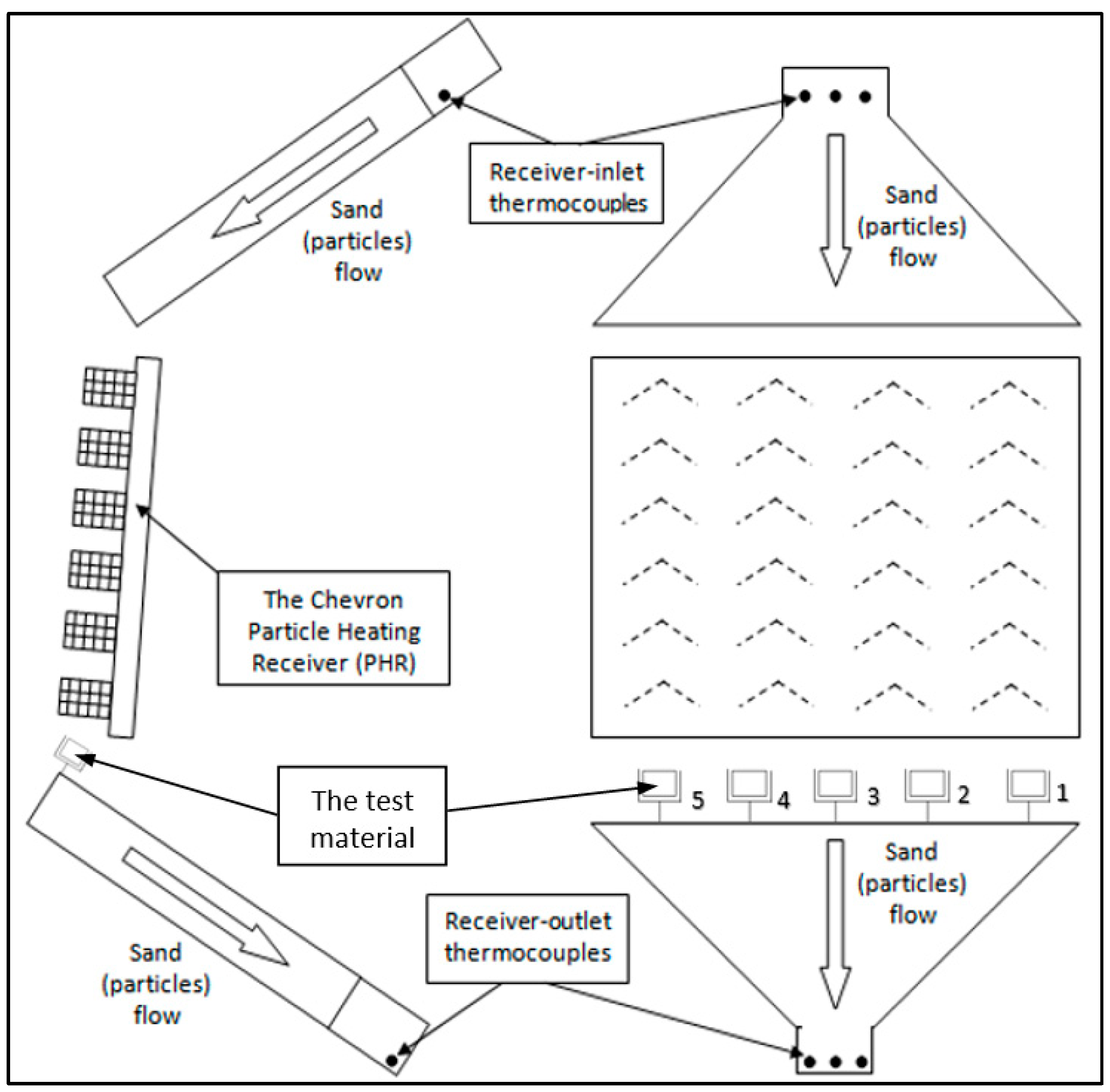

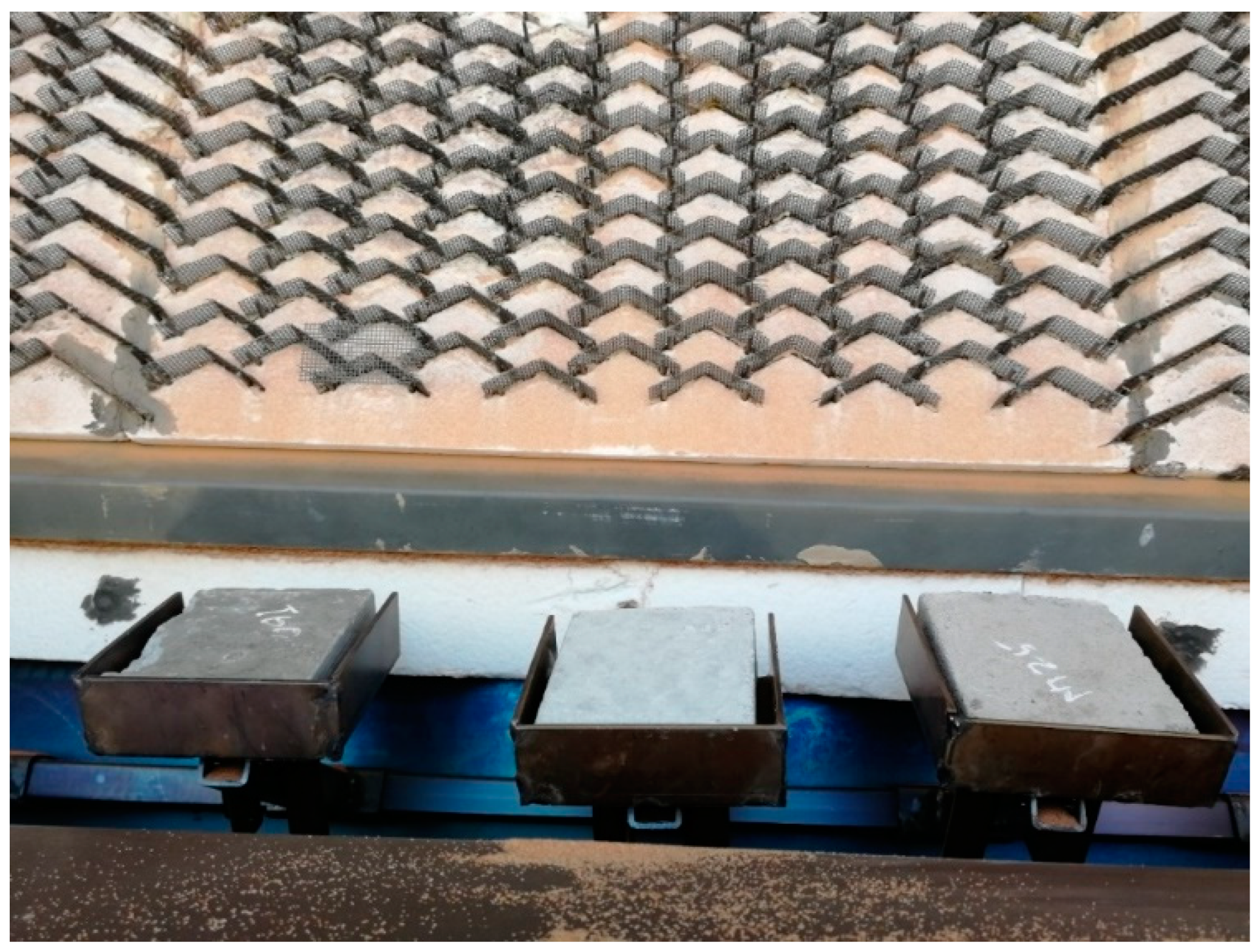

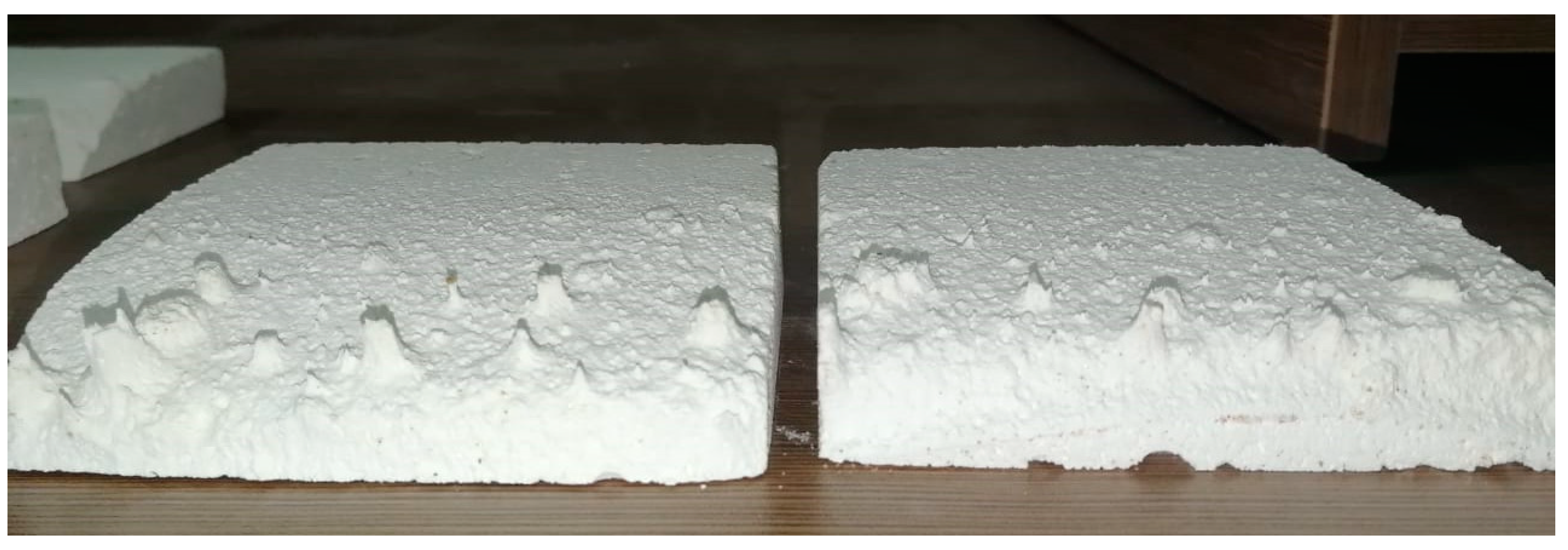
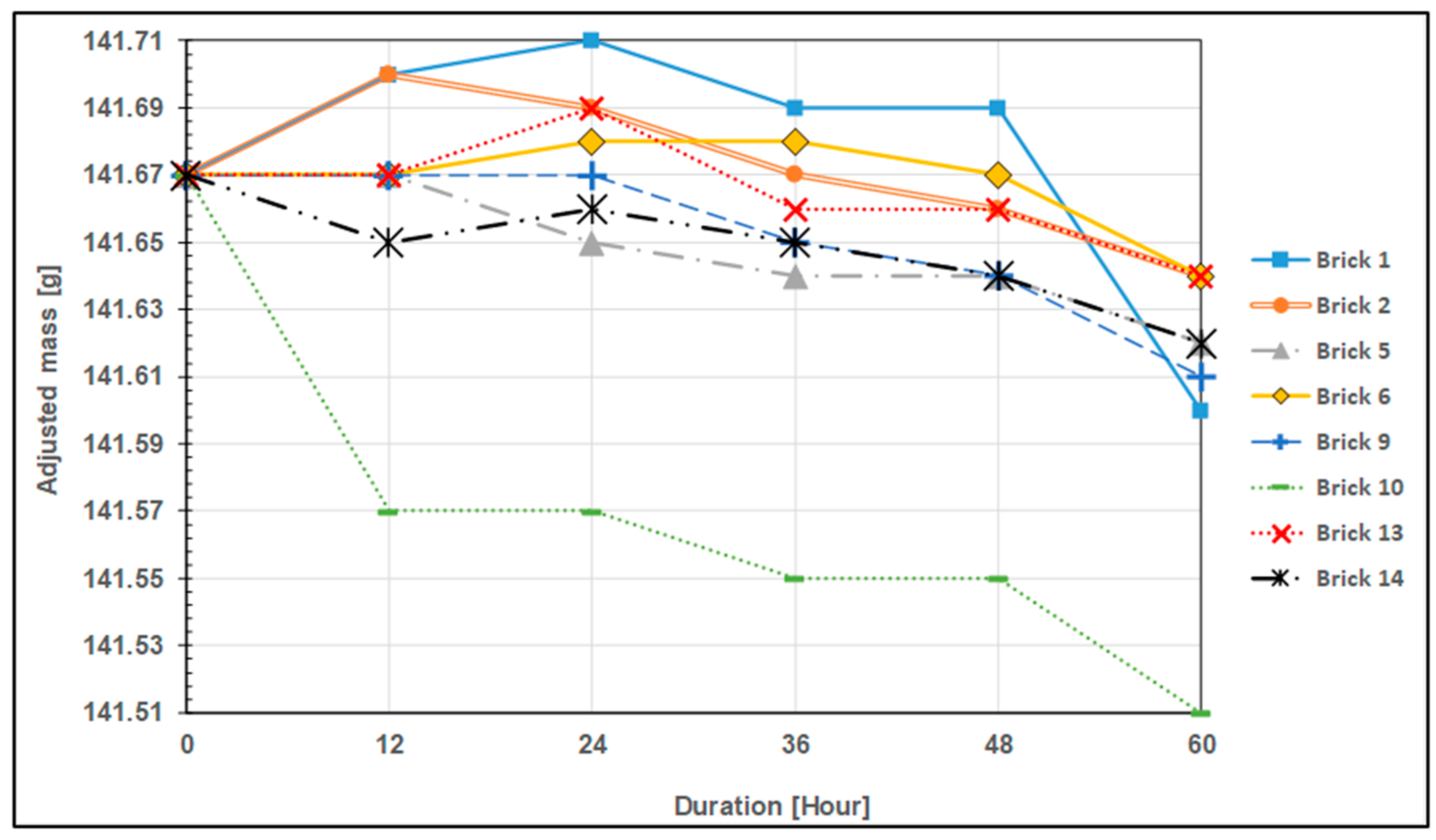
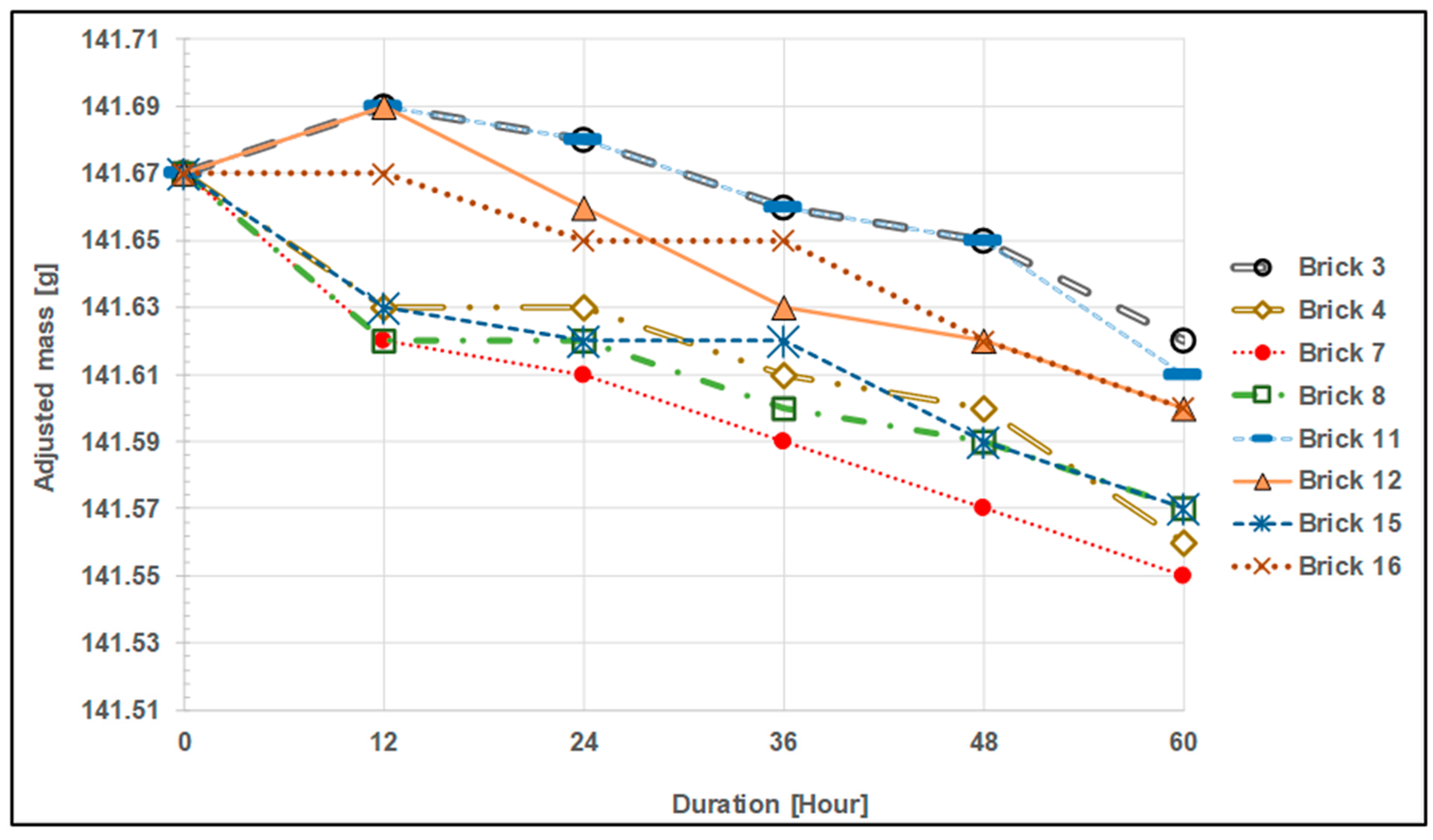
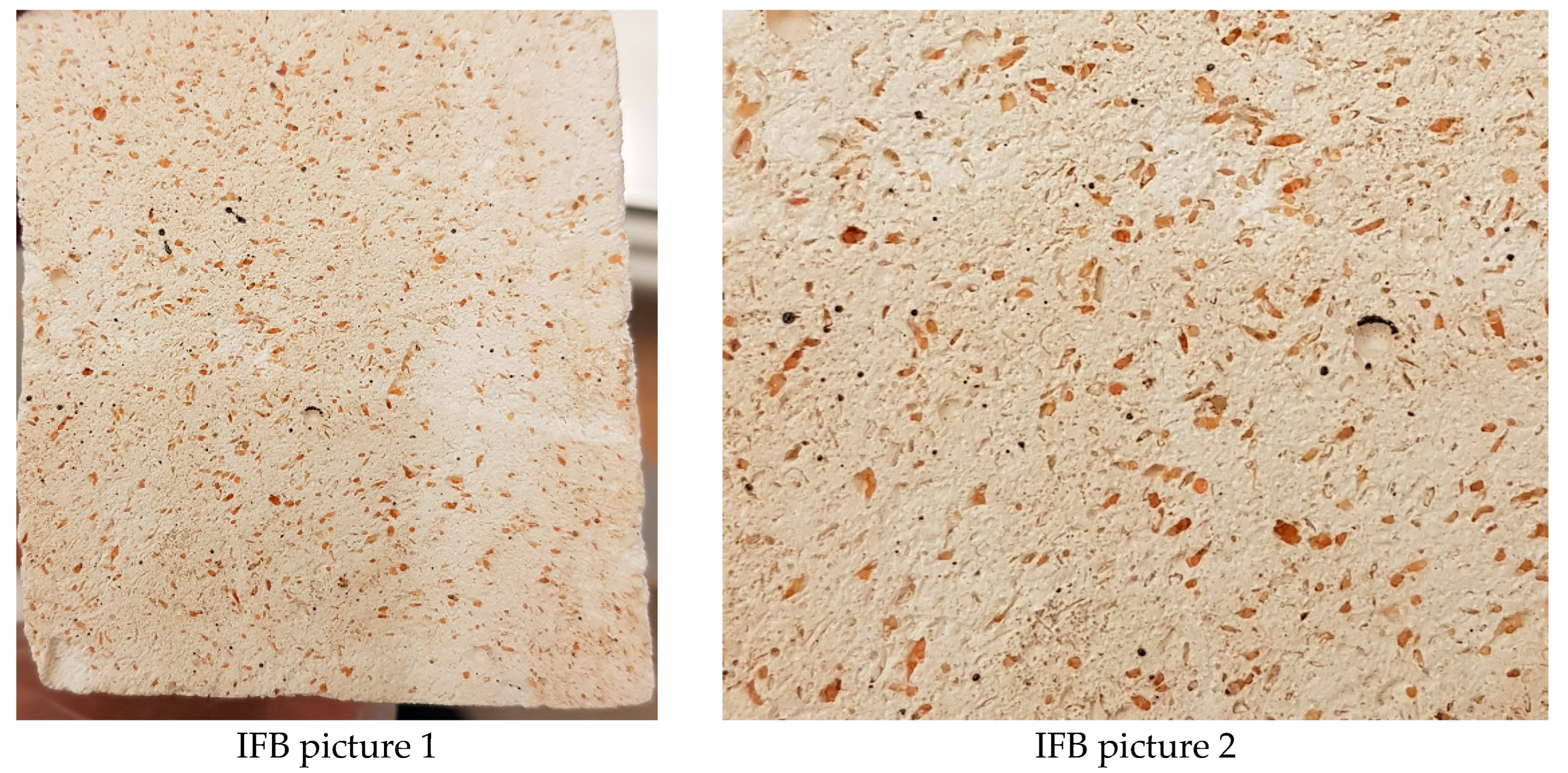
| Sample Number | Measured Mass (g) | Random Uncertainty |
|---|---|---|
| 1 | 133.43, 133.43, 133.43, 133.43, 133.42, 133.42 | ±0.004 |
| 12 | 135.11, 135.11, 135.11, 135.11, 135.12, 135.11, | ±0.003 |
| Al2O3 | SiO2 | CaO | Fe2O3 | TiO2 | Alkalis | Others | |
|---|---|---|---|---|---|---|---|
| Matrigun 25 ACX | 43.9% | 40.8% | 8.6% | 2.4% | - | - | 4.3% |
| Tuffcrete 47 | 47.1% | 46.5% | 2.1% | 0.8% | 2.0% | 1.1% | 0.1% |
| Tuffcrete 60 M | 60.5% | 34.3% | 1.9% | 0.9% | 1.9% | 0.2% | 0.3% |
| IFB [52] | 37.0% Min. | 46.0% Max. | 15.2 | 0.9% Max. | 0.5% | 1.9% Max. | - |
| Product Name | Description | Installation Method |
|---|---|---|
| M Matrigun 25 ACX | General purpose, non-wetting to aluminum, super duty gunning mix | Vibration, pumping, shotcrete, self-flow, gunning, hand packing |
| Tuffcrete 47 | Fire clay-based low-cement mix | Vibration, pumping, shotcrete, self-flow |
| Tuffcrete 60 M | Alumina-based, low-cement, high-purity castable | Vibration, pumping, shotcrete, self-flow |
| Sample | Initial Mass (±0.01g) | Mass after Test (±0.01g) | Loss (±0.01g) | Loss (%) |
|---|---|---|---|---|
| 1 | 84.78 | 77.83 | 06.95 | 08.19 |
| 2 | 96.21 | 82.85 | 13.36 | 13.89 |
| 3 | 77.71 | 67.03 | 10.68 | 13.74 |
| 4 | 82.57 | 74.78 | 07.79 | 09.43 |
| 5 | 84.49 | 66.60 | 17.89 | 21.18 |
| IFB Coated with | Initial Mass [±0.01 g] | Mass after Test [±0.01 g] | Mass Loss [±0.01 g] |
|---|---|---|---|
| Matrigun 25 ACX | 708.47 | 686.93 | 21.54 |
| Tuffcrete 47 | 827.07 | 825.06 | 02.01 |
| Tuffcrete 60 M | 803.54 | 802.07 | 01.47 |
| Brick no. | Initial Mass, 0 h [g] | After Run 1, 12 h [g] | Δm_1 [g] | After Run 2, 24 h [g] | Δm_2 [g] | After Run 3, 36 h [g] | Δm_3 [g] | After Run 4, 48 h [g] | Δm_4 [g] | After Run 5, 60 h [g] | Δm_5 [g] |
|---|---|---|---|---|---|---|---|---|---|---|---|
| 1 | 133.43 | 133.46 | 0.03 | 133.47 | 0.04 | 133.45 | 0.02 | 133.45 | 0.02 | 133.36 | −0.07 |
| 2 | 125.52 | 125.55 | 0.03 | 125.54 | 0.02 | 125.52 | 0.00 | 125.51 | −0.01 | 125.49 | −0.03 |
| 3 | 139.42 | 139.44 | 0.02 | 139.43 | 0.01 | 139.41 | −0.01 | 139.40 | −0.02 | 139.37 | −0.05 |
| 4 | 132.88 | 132.84 | −0.04 | 132.84 | −0.04 | 132.82 | −0.06 | 132.81 | −0.07 | 132.77 | −0.11 |
| 5 | 131.74 | 131.74 | 0.00 | 131.72 | −0.02 | 131.71 | −0.03 | 131.71 | −0.03 | 131.69 | −0.05 |
| 6 | 131.06 | 131.06 | 0.00 | 131.07 | 0.01 | 131.07 | 0.01 | 131.06 | 0.00 | 131.03 | −0.03 |
| 7 | 127.04 | 126.99 | −0.05 | 126.98 | −0.06 | 126.96 | −0.08 | 126.94 | −0.10 | 126.92 | −0.12 |
| 8 | 116.77 | 116.72 | −0.05 | 116.72 | −0.05 | 116.70 | −0.07 | 116.69 | −0.08 | 116.67 | −0.10 |
| 9 | 128.76 | 128.76 | 0.00 | 128.76 | 0.00 | 128.74 | −0.02 | 128.73 | −0.03 | 128.70 | −0.06 |
| 10 | 139.11 | 139.01 | −0.10 | 139.01 | −0.10 | 138.99 | −0.12 | 138.99 | −0.12 | 138.95 | −0.16 |
| 11 | 135.40 | 135.42 | 0.02 | 135.41 | 0.01 | 135.39 | −0.01 | 135.38 | −0.02 | 135.34 | −0.06 |
| 12 | 135.11 | 135.13 | 0.02 | 135.10 | −0.01 | 135.07 | −0.04 | 135.06 | −0.05 | 135.04 | −0.07 |
| 13 | 127.57 | 127.57 | 0.00 | 127.59 | 0.02 | 127.56 | −0.01 | 127.56 | −0.01 | 127.54 | −0.03 |
| 14 | 141.67 | 141.65 | −0.02 | 141.66 | −0.01 | 141.65 | −0.02 | 141.64 | −0.03 | 141.62 | −0.05 |
| 15 | 128.36 | 128.32 | −0.04 | 128.31 | −0.05 | 128.31 | −0.05 | 128.28 | −0.08 | 128.26 | −0.10 |
| 16 | 123.37 | 123.37 | 0.00 | 123.35 | −0.02 | 123.35 | −0.02 | 123.32 | −0.05 | 123.30 | −0.07 |
| Mass | Duration of Experiment [h] | |||||
|---|---|---|---|---|---|---|
| 0 | 12 | 24 | 36 | 48 | 60 | |
| Brick 14 [g] | 141.7 | 141.7 | 141.7 | 141.7 | 141.6 | 141.6 |
| Brick 15 [g] | 128.4 | 128.3 | 128.3 | 128.3 | 128.3 | 128.3 |
| Offset Mass-Brick 15 [g] | 13.3 | |||||
| Corrected Mass-Brick 15 [g] | 141.7 | 141.6 | 141.6 | 141.6 | 141.6 | 141.6 |
| Brick # | Surface Area of Tested Brick [m2] | Slope [g/h] | Rate of Mass Loss per Unit Area [g/h·m2] |
|---|---|---|---|
| 2 | 0.00336 | −0.0013 | 0.387 |
| 3 | −0.0016 | 0.476 | |
| 4 | −0.0018 | 0.536 | |
| 5 | −0.0008 | 0.238 | |
| 6 | −0.0011 | 0.327 | |
| 7 | −0.0017 | 0.506 | |
| 8 | −0.0013 | 0.387 | |
| 9 | −0.0016 | 0.476 | |
| 10 | −0.0015 | 0.446 | |
| 11 | −0.0018 | 0.536 | |
| 12 | −0.0016 | 0.476 | |
| 13 | −0.0012 | 0.357 | |
| 14 | −0.0011 | 0.327 | |
| 15 | −0.0015 | 0.446 | |
| 16 | −0.0015 | 0.446 | |
| Average | 0.425 | ||
| Uncertainty | 0.047 |
Disclaimer/Publisher’s Note: The statements, opinions and data contained in all publications are solely those of the individual author(s) and contributor(s) and not of MDPI and/or the editor(s). MDPI and/or the editor(s) disclaim responsibility for any injury to people or property resulting from any ideas, methods, instructions or products referred to in the content. |
© 2024 by the authors. Licensee MDPI, Basel, Switzerland. This article is an open access article distributed under the terms and conditions of the Creative Commons Attribution (CC BY) license (https://creativecommons.org/licenses/by/4.0/).
Share and Cite
Al-Suhaibani, Z.; Saleh, N.S.; Alaqel, S.; Saeed, R.; Djajadiwinata, E.; Danish, S.N.; Al-Ansary, H.; El-Leathy, A.; Jeter, S. Vulnerability of Thermal Energy Storage Lining Material to Erosion Induced by Particulate Flow in Concentrated Solar Power Tower Systems. Materials 2024, 17, 1480. https://doi.org/10.3390/ma17071480
Al-Suhaibani Z, Saleh NS, Alaqel S, Saeed R, Djajadiwinata E, Danish SN, Al-Ansary H, El-Leathy A, Jeter S. Vulnerability of Thermal Energy Storage Lining Material to Erosion Induced by Particulate Flow in Concentrated Solar Power Tower Systems. Materials. 2024; 17(7):1480. https://doi.org/10.3390/ma17071480
Chicago/Turabian StyleAl-Suhaibani, Zeyad, Nader S. Saleh, Shaker Alaqel, Rageh Saeed, Eldwin Djajadiwinata, Syed Noman Danish, Hany Al-Ansary, Abdelrahman El-Leathy, and Sheldon Jeter. 2024. "Vulnerability of Thermal Energy Storage Lining Material to Erosion Induced by Particulate Flow in Concentrated Solar Power Tower Systems" Materials 17, no. 7: 1480. https://doi.org/10.3390/ma17071480






